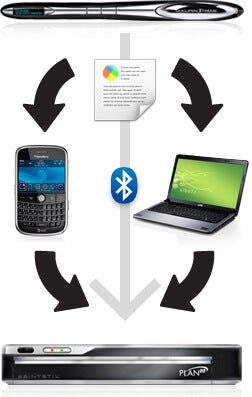
For anyone who has needed to scan pages from a book, the frustration of fumbling around with a flatbed scanner is all too familiar, not to mention what it does to a book’s binding. Now a Canadian company named PlanOn has reduced a flatbed scanner down to a handheld, compact device. The $159 ScanStik is a 9-inch long full page color scanner, which can scan a page at 150, 300 or 600 dpi in 24-bit color in just 4 seconds by swiping down the page. It has a MicroSD card slot for storage, a USB cable for transfer and battery recharging, and comes with OCR and document management software (for Windows). In the ever increasing push to go mobile, ScanStik offers a convenient and sleek way to bridge the gap between the print and digital worlds…well, at least for those who are not quite ready for the cloud.
PlanOn is introducing ScanStik as part of a larger set of products aimed at the mobile lifestyle, whether for work, school, or pleasure. In fact, ScanStik is the lower end version of their DocuPen series (starting at about $300) that is Bluetooth-enabled, making file transfer a lot easier and much more mobile for people who don’t want to mess around with MicroSD cards anymore. To complete the circle, PlanOn also makes a slightly larger full page thermal printer called PrintStik that comes with a paper cartridge capable of producing 20 monochrome pages (like a giant receipt). The Bluetooth version also comes in around $300. This means that the DocuPen/PrintStik combo can be used as a portable equivalent to a photocopier but it’s small enough to fit in a case with a laptop.

While it’s impressive that PlanOn has miniaturized a flatbed scanner into something the size of a long cigar, it seems that ScanStik will be useful only in specific situations, especially at that price point. The company is marketing heavily to mobile professionals, targeting salespeople or real estate agents that must handle and process a variety of documents on the go. It also could be useful when traveling out of town on business when similar services are costly or far from the hotel. For students or people researching in a library, ScanStik could let you scan as you browsed, so you wouldn’t have to worry about checking anything out. In everyday situations, the device could be helpful for digitizing receipts, whether you’re tracking expenses for a small business or just a household.
But the real issue is that ScanStik may have missed its window of broad usability and probably would have made a much bigger splash in the market if it had been released a few years ago. The reason is fairly straightforward: the momentum for scanning technology is heading toward smartphone apps that utilize built-in cameras and manage documents in the cloud.
First, smartphones and tablets are pervasive, increasingly becoming the de facto center of the mobile professional’s computational needs. Sure, a good smartphone is hundreds of dollars and has a monthly plan on top of it, but a recent Nielsen study showed that half of all mobile phones in the U.S. are smartphones, so many people are already paying for one. At the same time, notebook users who need peripherals are alive and well. In fact, analysts are forecasting a PC rebound in 2012 with a rise in laptop sales as well even after the iPad dominated notebooks in 2011 and global tablet sales are expected to nearly double in 2012, but the trend in technology is going to fewer devices, not more. Peripherals creating buzz are those that plug into smartphones, with the Square mobile reader being a prime example of using a smartphone’s horsepower and connectivity to the device’s advantage and a price point of only $10.
Second, the cameras on smartphones don’t suffer from the mediocre quality they used to when the original iPhone was released in 2007, but seeing is believing. Fortunately, Gizmodo has made a compilation of a dramatic analysis of the evolution of the iPhone’s cameras here:

Most cameras, like other peripherals, are quickly being replaced by smartphones because they are capable of making high quality images, including document scans, to the extent that a number of banks find them sufficient to accept as mobile deposits of checks.
Third, apps are king to the tune of 25 billion iOS apps and 10 billion Android apps downloaded, with a record-breaking 1.2 billion apps downloaded in just one week the last holiday season. In 2010, Singularity Hub covered ScanR, the iPhone app that let’s you make scans with your phone, covert them to PDFs, and fax them. Since then, a number of other apps that turn your smartphone into a scanner have been introduced for iOS and Android, all coming in at $10 or less. There’s even a rumor that an OCR scanner app may become native in future Apple devices.
Finally, cloud computing is where it’s at. Google just increased the storage size of Docs to 5GB along with Google Drive as a competitor to popular cloud storage services like DropBox and Microsoft’s SkyDrive. Adobe just introduced its Creative Suite, including Photoshop, Illustrator, and InDesign, as a cloud service, adding to their previous app offerings to SendNow and CreatePDF. So with the spread of wireless services, cloud storage is incredibly convenient for anyone managing a bunch of documents.
So ScanStik is cool technology and definitely an improvement over other products, like last year’s Visioneer Mobility or the recent Doxie page-fed scanners that are both larger and still over $100. It offers on-the-go convenience that a device like a page scanner than records 200 pages in a minute, still a prototype, couldn’t offer. For those who aren’t sold yet on cloud computing or have documents in which security is an issue, ScanStik is a great solution as well. And if a pricey smartphone with its costly monthly upkeep is of no interest, then the $159 device could seem like a bargain.
But based on where things are headed, this latest technology from PlanOn may not be around for long as the world of print fades, life moves increasingly into the cloud, and the digitalization of everything reaches full speed. Thankfully though, between the ScanStik, sheet fed document scanners, and smartphones, flatbed scanners will soon be history.
[Media: Campl.us via Gizmodo, PlanOn]
[Sources: PlanOn]



